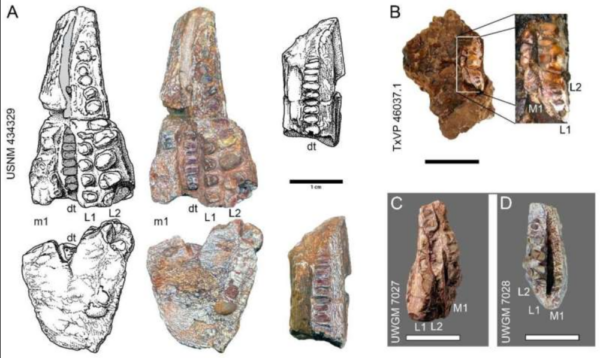Once upon a time, the ancestors of birds, crocodiles, and dinosaurs roamed the range in what is now Wyoming. A lizard-like organism with a beak that consumed plants approximately 232 million years ago has been described in a journal article titled Diversity.
The new taxon, described by the University of Wisconsin-Madison researchers in “A New Rhynchosaur Taxon from the Popo Agie Formation, WY: Implications for a Northern Pangean Early-Late Triassic (Carnian) Fauna,” was discovered previously, but the initial specimens’ surface texture and morphological features were too eroded for comparative use.
Using the distinctive dental morphology of 12 new specimens, paleontologists were able to corroborate that it was a new species of Rhynchosauria. Five specimens provided sufficient morphological evidence to assign this rhynchosaur to the subfamily Hyperodapedontinae.
Beessiiwo (Bah—se—wa) cooowuse (ja’ aw-wu sa) is the taxonomic name given to the new species by the First Nation co-authors of the study. The name means “big lizard from the Alcova area” (Alcova is an area in central Wyoming), as the specimens were collected on the lands of the Northern Arapaho. This large lizard was tiny compared to the large reptiles that would later dominate the landscape, measuring approximately 0.5 meters in length.

The fossils were discovered in the Popo Agie Formation of Wyoming, a stratum of sediment deposited during the Triassic period in what were once rivers or lake beds when Wyoming was a part of the Northern Pangean supercontinent millions of years ago.
Discovering, characterizing, and naming the fossils was easier than placing them in the Late Triassic Carnian lizard lexicon.
It was a time of significant early diversification, so overlapping definitions based on past discoveries, which may be tens of millions of years apart and share characteristics from common ancestors but are as evolutionarily distant as apes and monkeys, have resulted in the rise and fall of numerous classification schemes.
In addition, numerous diverse taxa of these related creatures lived in close proximity, with overlapping territories, and are occasionally discovered co-occurring at certain sites, which can bewilder even the most devoted paleontologist.

Beessiiwo cooowuse resembled and was likely a sister species of the recently described Oryctorhynchus bairdi found in Nova Scotia, Canada, but it was not an exact match. After unsuccessfully attempting to fit Beessiiwo into any of the available categories, the researchers determined that it would be best to assign it its own.
In Wyoming, early to late Triassic fauna has yet to be discovered, according to the authors. The Popo Agie Formation extends from west-central Wyoming to northeastern Utah and parts of Colorado. It is one of the few places in North America where this genuinely ancient non-marine continental strata is readily accessible from the surface.

